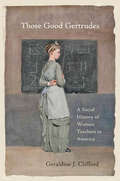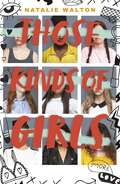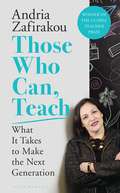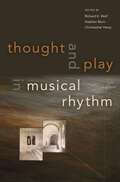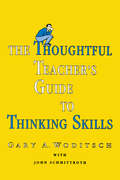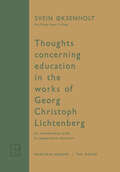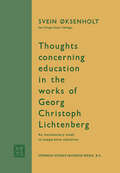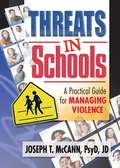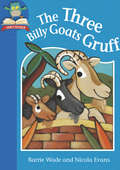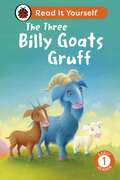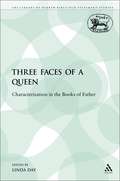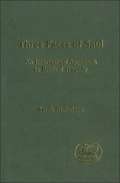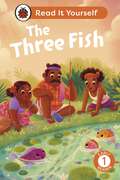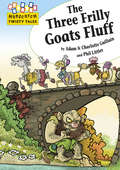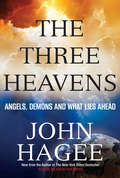- Table View
- List View
Those Good Gertrudes: A Social History of Women Teachers in America
by Geraldine J. CliffordThose Good Gertrudes explores the professional, civic, and personal roles of women teachers throughout American history. Its voice, themes, and findings build from the mostly unpublished writings of many women and their families, colleagues, and pupils. Geraldine J. Clifford studied personal history manuscripts in archives and consulted printed autobiographies, diaries, correspondence, oral histories, interviews;¢;‚¬;€?even film and fiction;¢;‚¬;€?to probe the multifaceted imagery that has surrounded teaching.This broad ranging, inclusive, and comparative work surveys a long past where schoolteaching was essentially men's work, with women relegated to restricted niches such as teaching rudiments of the vernacular language to young children and socializing girls for traditional gender roles. Clifford documents and explains the emergence of women as the prototypical schoolteachers in the United States, a process apparent in the late colonial period and continuing through the nineteenth century, when they became the majority of American public and private schoolteachers.The capstone of Clifford;€™s distinguished career and the definitive book on women teachers in America, Those Good Gertrudes will engage scholars in the history of education and women;€™s history, teachers past, present, and future, and readers with vivid memories of their own teachers.
Those Kinds of Girls (A Wattpad Novel)
by Natalie WaltonDouble standards are about to get singled out.As lead reporter for her school newspaper, Eden has covered her fair share of stories. So when intimate photos of seven female students are anonymously emailed to the entire school, Eden is determined to get to the bottom of it. As she digs deeper into the mystery, Eden is shocked to discover not everyone agrees the students are victims. Some argue that they're 'those kinds of girls' and 'brought it on' - and the school's administrator is more concerned about protecting the school's reputation than its students. With the anonymous sender threatening more emails, Eden needs to act quickly. Banding together with the seven young women to find the perpetrator, the tables are about to be turned . . . The girls are fighting back.Natalie Walton's empowering and sparky debut is a feminist mystery story - perfect for fans of A Good Girl's Guide to Murder and Netflix's Sex Education.
Those Who Can, Teach: What It Takes To Make the Next Generation
by Andria ZafirakouThe powerful, inspiring story of Andria Zafirakou, 'the best teacher in the world', and what it takes to work on the frontlines of education today'A clarion call for people to value the arts in state education, as well as a powerful reminder that a teacher ready to listen can transform a young person's life' i'I haven't read a book for a long time that so often had me close to tears – not for the deprivations described, but for the everyday efforts to overcome them' Observer'An inspirational book . . . You can call this good teaching; what it looks like is love' Evening StandardArts teacher Andria Zafirakou was always a rule-breaker. At her inner-city London school where more than eighty languages are spoken, she would sense urgent needs; mending uniforms, calling social services, shielding vulnerable teens from gangs. And she would tailor each class to its pupils, fiercely believing in the power of art to unlock trauma, or give a mute child the confidence to speak. Time and again, she would be proved right. So in 2018, when Andria won the million-dollar Global Teacher Prize, she knew exactly where the money would go: back into arts education for all. Because today, the UK government's cuts and curriculum changes are destroying the arts, while their refusal to tackle the most dangerous threats faced by children – cyber-bullying, gang violence, hunger and deprivation – puts teachers on the safeguarding frontline. Andria's story is a rallying wake-up call that shows what life is really like for schoolchildren today, and a moving insight into the extraordinary people shaping the next generation.Praise for Andria Zafirakou:'A magic combination of belief and compassion' Financial Times'Andria Zafirakou should be an inspiration to all' i'Zafirakou's generosity offers a gleam of hope in a world that can seem unremittingly dark' Guardian'An amazing person . . . What struck me was just her sheer joy' Jeremy Vine, BBC Radio 2'Where others might have given up, Andria has made it her mission to ensure [her students] get the best possible start in life' Daily Mail
Thought and Play in Musical Rhythm
Thought and Play in Musical Rhythm offers new understandings of musical rhythm through the analysis and comparison of diverse repertoires, performance practices, and theories as formulated and transmitted in speech or writing. Editors Richard K. Wolf, Stephen Blum, and Christopher Hasty address a productive tension in musical studies between universalistic and culturally relevant approaches to the study of rhythm. Reacting to commonplace ideas in (Western) music pedagogy, the essays explore a range of perspectives on rhythm: its status as an "element" of music that can be usefully abstracted from timbre, tone, and harmony; its connotations of regularity (or, by contrast, that rhythm is what we hear against the grain of background regularity); and its special embodiment in percussion parts. Unique among studies of musical rhythm, the collection directs close attention to ways performers and listeners conceptualize aspects of rhythm and questions many received categories for describing rhythm. By drawing the ear and the mind to tensions, distinctions, and aesthetic principles that might otherwise be overlooked, this focus on local concepts enables the listener to dispel assumptions about how music works "in general." Readers may walk away with a few surprises, become more aware of their assumptions, and/or think of new ways to shock their students out of complacency.
THOUGHT & PLAY IN MUSICAL RHYTHM C
by Richard K. Wolf, Stephen Blum, and Christopher HastyThought and Play in Musical Rhythm offers new understandings of musical rhythm through the analysis and comparison of diverse repertoires, performance practices, and theories as formulated and transmitted in speech or writing. Editors Richard K. Wolf, Stephen Blum, and Christopher Hasty address a productive tension in musical studies between universalistic and culturally relevant approaches to the study of rhythm. Reacting to commonplace ideas in (Western) music pedagogy, the essays explore a range of perspectives on rhythm: its status as an "element" of music that can be usefully abstracted from timbre, tone, and harmony; its connotations of regularity (or, by contrast, that rhythm is what we hear against the grain of background regularity); and its special embodiment in percussion parts. Unique among studies of musical rhythm, the collection directs close attention to ways performers and listeners conceptualize aspects of rhythm and questions many received categories for describing rhythm. By drawing the ear and the mind to tensions, distinctions, and aesthetic principles that might otherwise be overlooked, this focus on local concepts enables the listener to dispel assumptions about how music works "in general." Readers may walk away with a few surprises, become more aware of their assumptions, and/or think of new ways to shock their students out of complacency.
The Thoughtful Teacher's Guide To Thinking Skills
by Gary A. WoditschFrom the vantage of new cognitive theory, this book manages to integrate the thinking skill mission across the full range of formal instruction, from K through graduate school. It explores and prioritizes thinking skill aims at each instructional level, and then details how classroom practice can adjust to achieve those aims. This guide leads to solid ground, perspective and technique for the individual teacher at any level who wants to enhance thinking skill development. It will prove indispensable to those planning curriculum with a thinking skill emphasis.
The Thoughtful Teacher's Guide To Thinking Skills
by Gary A. WoditschFrom the vantage of new cognitive theory, this book manages to integrate the thinking skill mission across the full range of formal instruction, from K through graduate school. It explores and prioritizes thinking skill aims at each instructional level, and then details how classroom practice can adjust to achieve those aims. This guide leads to solid ground, perspective and technique for the individual teacher at any level who wants to enhance thinking skill development. It will prove indispensable to those planning curriculum with a thinking skill emphasis.
Thoughtings: Puzzles, problems and paradoxes in poetry to think with (The\philosophy Foundation Ser.)
by Peter Worley Andrew DayThe name 'Thoughtings' was inspired by a 5-year old who, when asked to explain what thinking is without using the word 'think' said 'It's when you're thoughting'. Children love pondering big philosophical questions like 'Does the universe end?', 'Where is my mind?' and 'Can something be true and false at the same time?'. These verses capture that impulse in the growing mind and feed it further. These are not poems or, at least, not in the traditional sense of the word... They are a kind of poem specifically designed around a particular puzzle or problem that might be thought more philosophy than poetry. Here's to the joy of puzzlement!
Thoughts Concerning Education in the Works of Georg Christoph Lichtenberg: An Introductory Study in Comparative Education
by Svein OksenholtThis is an investigation of the thoughts concerning education in the writings of one of the most original educators of the eighteenth century. Unappreciated and largely overlooked - as was Schopenhauer - by the contemporary educators, Lichtenberg nevertheless presented his generation, and generations to come, with some of the most useful (a great life aim of Horace Mann!) suggestions pertaining to education that may possibly be found anywhere in the annals of classical edu cation. Beginning with a biographical sketch of Lichtenberg, it presents an analysis of his philosophy of education, discusses Lichtenberg's thoughts on pedagogy and curriculum, analyzes his conception of morals and religion to the extent that these ideas are specifically related to education, examines his notions of educational psychology, determines Lichtenberg's views on British education in the eighteenth century, compares some of Lichtenberg's educational ideas in the works of contemporary thinkers and educators, notably Schopenhauer, James and Dewey. A concomitant aspect of this book is a portrayal of Lichtenberg as found in his works, viz., as a student, professor, philosopher, educator, moralist, psychologist, comparative educationist, as a searcher for absolute educational truth - attainable only in a world to come. SVEIN 0KSENHOLT, PH. D.
Thoughts Concerning Education in the Works of Georg Christoph Lichtenberg: An Introductory Study in Comparative Education
by Svein ØksenholtThis is an investigation of the thoughts concerning education in the writings of one of the most original educators of the eighteenth century. Unappreciated and largely overlooked - as was Schopenhauer - by the contemporary educators, Lichtenberg nevertheless presented his generation, and generations to come, with some of the most useful (a great life aim of Horace Mann!) suggestions pertaining to education that may possibly be found anywhere in the annals of classical edu cation. Beginning with a biographical sketch of Lichtenberg, it presents an analysis of his philosophy of education, discusses Lichtenberg's thoughts on pedagogy and curriculum, analyzes his conception of morals and religion to the extent that these ideas are specifically related to education, examines his notions of educational psychology, determines Lichtenberg's views on British education in the eighteenth century, compares some of Lichtenberg'S educational ideas in the works of contemporary thinkers and educators, notably Schopenhauer, J ames and Dewey. A concomitant aspect of this book is a portrayal of Lichtenberg as found in his works, viz., as a student, professor, philosopher, educator, moralist, psychologist, comparative educationist, as a searcher for absolute educational truth - attainable only in a world to come. San Diego State College SVEIN 0KSENHOLT, PH. D.
Threads of Thinking: Schemas and Young Children's Learning
by Cathy NutbrownIn her new edition of this popular book, Cathy Nutbrown presents evidence of continuity and progression in young children's thinking. She shows, with detailed observation, that they are able and active learners. She considers aspects of children's patterns of learning and thinking - or schemas - and demonstrates clearly how children learn in an active, dynamic and creative way. This book makes schema theory explicit in practice. Supported by numerous detailed examples and the discussion of difficult theoretical issues, it illustrates children's learning in areas such as literacy, maths and science. This new edition includes: - discussion on the need for professional development - changes in early years pedagogy - more discussion of theories of learning in relation to curriculum and teaching practices - new examples of children's drawings - new suggestions for using stories to support schemas. Threads of Thinking is for early years practitioners who wish to support and develop children's learning. Professor Cathy Nutbrown is Director of Studies in Early Childhood Education at the University of Sheffield.
Threads of Thinking: Schemas and Young Children's Learning
by Cathy NutbrownIn her new edition of this popular book, Cathy Nutbrown presents evidence of continuity and progression in young children's thinking. She shows, with detailed observation, that they are able and active learners. She considers aspects of children's patterns of learning and thinking - or schemas - and demonstrates clearly how children learn in an active, dynamic and creative way. This book makes schema theory explicit in practice. Supported by numerous detailed examples and the discussion of difficult theoretical issues, it illustrates children's learning in areas such as literacy, maths and science. This new edition includes: - discussion on the need for professional development - changes in early years pedagogy - more discussion of theories of learning in relation to curriculum and teaching practices - new examples of children's drawings - new suggestions for using stories to support schemas. Threads of Thinking is for early years practitioners who wish to support and develop children's learning. Professor Cathy Nutbrown is Director of Studies in Early Childhood Education at the University of Sheffield.
Threats in Schools: A Practical Guide for Managing Violence
by Joseph T MccannManage potentially violent situations in your school with these expert techniques!In the wake of several highly publicized school shootings, the problem of school violence has increasingly become a focus of concern for the general public as well as teachers, school officials, and students. Drawing on case studies from publicized violent incidents as well as from Dr. McCann's private practice, Threats in Schools: A Practical Guide for Managing Violence provides techniques for identifying, conceptualizing, assessing, and managing threatening behavior by students in school settings. Offering specific case management strategies for a variety of situations, this indispensable volume provides guidance on formulating questions to ask and suggestions for developing strategies for managing potentially violent situations.Integrating threat assessment and risk management models, this approach will help you target potential threats to property, other students, teachers, and school staff. The interdisciplinary approach recognizes that violent behavior is dependent on the characteristics of the perpetrator, victim, and setting, and that the relationship between threats and violence is not always clear. Threats in Schools offers well-grounded research, detailed case studies, and theoretical approaches to help you deal with the tough issues, including: zero-tolerance policies and their more effective alternatives why profiling techniques to identify violence-prone students are of limited use interventions to defuse potentially violent situations critical incident stress managementFive appendixes offer forms and checklists to help you plan and evaluate, including: threat assessment and management planning checklist of characteristics of perpetrators of school violence questions for evaluating general risk of violence fire-setting and bombing risk assessment sex offense risk assessmentLucidly written and illustrated with helpful tables and figures, Threats in Schools offers school officials, mental health professionals, community leaders, and the media the information they need to understand what sparks school violence and which approaches reduce the risk of it.
Threats in Schools: A Practical Guide for Managing Violence
by Joseph T MccannManage potentially violent situations in your school with these expert techniques!In the wake of several highly publicized school shootings, the problem of school violence has increasingly become a focus of concern for the general public as well as teachers, school officials, and students. Drawing on case studies from publicized violent incidents as well as from Dr. McCann's private practice, Threats in Schools: A Practical Guide for Managing Violence provides techniques for identifying, conceptualizing, assessing, and managing threatening behavior by students in school settings. Offering specific case management strategies for a variety of situations, this indispensable volume provides guidance on formulating questions to ask and suggestions for developing strategies for managing potentially violent situations.Integrating threat assessment and risk management models, this approach will help you target potential threats to property, other students, teachers, and school staff. The interdisciplinary approach recognizes that violent behavior is dependent on the characteristics of the perpetrator, victim, and setting, and that the relationship between threats and violence is not always clear. Threats in Schools offers well-grounded research, detailed case studies, and theoretical approaches to help you deal with the tough issues, including: zero-tolerance policies and their more effective alternatives why profiling techniques to identify violence-prone students are of limited use interventions to defuse potentially violent situations critical incident stress managementFive appendixes offer forms and checklists to help you plan and evaluate, including: threat assessment and management planning checklist of characteristics of perpetrators of school violence questions for evaluating general risk of violence fire-setting and bombing risk assessment sex offense risk assessmentLucidly written and illustrated with helpful tables and figures, Threats in Schools offers school officials, mental health professionals, community leaders, and the media the information they need to understand what sparks school violence and which approaches reduce the risk of it.
The Three Billy Goats Gruff: The Three Billy Goats Gruff Leapfrog:the Three Billy Goats Gruf (Must Know Stories: Level 1)
by Barrie Wade"Who's that trip-trapping over MY bridge?" roared the troll.A beautifully illustrated retelling of this favourite traditional story. Join the three billy goats as they try to outwit the troll and reach the meadow on the other side of his bridge.Must Know Stories includes favourite tales, celebrating the diversity of our literary heritage. Level 1 stories are told in under 500 words, for children to read independently.
The Three Billy Goats Gruff: Read It Yourself - Level 1 Early Reader (Read It Yourself)
by LadybirdBased on the well-loved classic tale. The three billy goats Gruff want to eat the grass on the other side of the bridge. There's only one problem, a giant troll is lurking underneath! Will the billy goats Gruff find a way to make it past the grumpy old troll?The Three Billy Goats Gruff is from Early Reader Level 1 and is perfect for children aged from 4+ who are taking their first steps beyond phonics.Each book has been carefully checked by educational and subject consultants and includes comprehension puzzles, book band information, and tips for helping children with their reading.With five levels to take children from first phonics to fluent reading and a wide range of different stories and topics for every interest, Read It Yourself helps children build their confidence and begin reading for pleasure.
Three Decades of Peace Education around the World: An Anthology (Reference Books in International Education #Vol. 24)
by Robin J. Burns Robert AspeslaghFirst Published in 1996. Routledge is an imprint of Taylor & Francis, an informa company.
Three Decades of Peace Education around the World: An Anthology (Reference Books in International Education)
by Robin J. Burns Robert AspeslaghFirst Published in 1996. Routledge is an imprint of Taylor & Francis, an informa company.
Three Dimensional Creativity: Three Navigations to Extend our Thoughts (KAIST Research Series)
by Kwang Hyung LeeIs creativity something that we are simply born with and cannot hone with effort? Some say that creativity cannot be cultivated. Is it true? In general our thinking sticks to reality unless there is any external stimulation. With our thinking fixed on a certain situation, it becomes difficult to come up with a fresh idea. In this regard, three questions are suggested: (1) Question of Time: When a problem arises, question yourself on a time axis first of all. How would the matter be handled 10 or 20 years from now? (2) Question of Space: Ask yourself some questions on its spatial elements. How would the matter be handled in Saudi Arabia or in China? (3) Question of Field: Apply the given problem in a variety of fields. How would the matter be handled in the field of music or electronic engineering?The three questions suggested here are given on the three axes: time, space, and field, and this book deals with theoretical and practical aspects on the topics. In this way it is a unique book about the systematic method of developing creativity, which will have appeal to researchers and students in multidisciplinary fields from neuroscience to physics, and engineering and computer science, as well as a general public.
Three Dimensions: A Model of Goal and Theory Description in Mathematics Instruction — The Wiskobas Project (Mathematics Education Library #3)
by A. TreffersIn Dutch "WISKOBAS" stands for a particular kind of mathematics in the elementary school (ages 6-12). In tum Wiskobas was one of the depart ments in the IOWO, the Institute for the Development of Mathematics Education. This institute was concerned with the development of material for mathematics education as well as the related research on the possibility of change from the then existing arithmetic instruction to the future mathematics education. The present publication Three Dimensions has three aims: to give a picture of the goals Wiskobas set for future mathematics education, at the same time to show how such goals can be described, and to show the theoretical framework of the Wiskobas curriculum. The problem at hand is not at all simple. What is more, Wiskobas' ideas about mathematics education cannot literally be translated into strings of words. So how can we face the accusation that our objectives are unattain able and the goal itself irrational? In order to avoid this vagueness as much as possible and for the sake of clarity, this book makes continuous use of illustrations of mathematics education. In these examples both the subject-matter and the methods of description of the goals are illustrated as explicitly as possible, while at the same time creating the opportunity to read between the lines. The reader is urged to follow carefully the mathe matical material at the start of each chapter. This advice applies both to the more general education oriented, and to the more mathematical! didactical reader.
Three Faces of a Queen: Characterization in the Books of Esther (The Library of Hebrew Bible/Old Testament Studies)
by Linda DayThis original study offers, for the first time, an analysis of the characterization of Esther as she is portrayed in each of the three primary versions of the book of Esther-the Masoretic text, the Septuagint text, and the Greek a text. This study of characterization has implications beyond itself. It permits a reasssessment of relations between the book of Esther and other literature of the time, it sheds light on the place of origin of the ancient versions of Esther, and it raises serious feminist and canon-critical questions about the role of the book.
Three Faces of Saul: An Intertextual Approach to Biblical Tragedy (The Library of Hebrew Bible/Old Testament Studies)
by Sarah NicholsonA fascinating intertextual study of the classic biblical tragedy of Saul, the first king of Israel, as first narrated in biblical narrative and later reworked in Lamartine's drama Saul: Tragédie and Thomas Hardy's novel The Mayor of Casterbridge. Plot and characterization are each explored in detail in this study, and in each of the narrations the hero's tragic fate emerges both as the result of a character flaw and also as a consequence of the ambivalent role of the deity, showing a double theme underlying not only the biblical vision but also its two very different retellings nearer to our own times.
The Three Fish: Read It Yourself - Level 1 Early Reader (Read It Yourself)
by LadybirdBased on a popular Panchatantra story from India. Fishers have come along to the pond where three big fish live. When faced with danger, the fish make a plan to escape. Will all three of the fish get away in time?The Three Fish is from Early Reader Level 1 and is perfect for children aged from 4+ who are taking their first steps beyond phonics.Each book has been carefully checked by educational and subject consultants and includes comprehension puzzles, book band information, and tips for helping children with their reading.With five levels to take children from first phonics to fluent reading and a wide range of different stories and topics for every interest, Read It Yourself helps children build their confidence and begin reading for pleasure.
The Three Frilly Goats Fluff (Hopscotch: Twisty Tales #9)
by Charlotte Guillain Adam GuillainIn this classic twist on the traditional fairy tale, meet three fashionista goats. They love all things frilly. But will the troll share their passion for fashion? The carefully controlled text level and fun illustrations ensure this is a fantastic read for all children of all reading levels!
The Three Heavens: Angels, Demons and What Lies Ahead
by John HageeAs sales of Hagee's current New York Times bestseller, Four Blood Moons, continue to soar, hundreds of thousands of readers have had their thirst whetted to know what is to come at the end of this world . . . heaven itself! Hagee's national media power assures another mega-bestseller.
